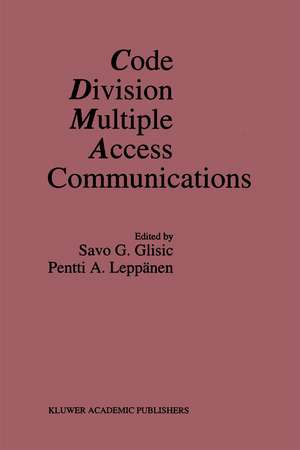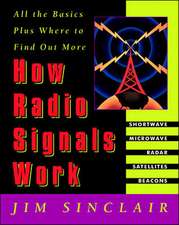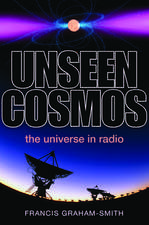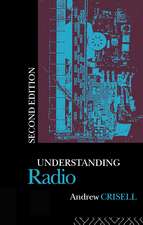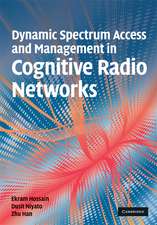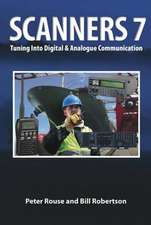Code Division Multiple Access Communications
Editat de Savo G. Glisic, Pentti A. Leppänenen Limba Engleză Paperback – 10 oct 2012
Code Division Multiple Access Communications comprises a set of contributions from the most distinguished world scientists in the field. These papers review the basic theory and some of the most important problems related to spread spectrum and CDMA. The topics covered centre on the information theory aspects of CDMA; interference suppression and performance analysis.
The material presented in this book summarises the main problems in modern CDMA theory and practice and gives a solid starting point for studying this complex and still challenging field. As such Code Division Multiple Access Communications is essential reading for all researchers and designers working in mobile communication systems and provides an excellent text for a course on the subject.
| Toate formatele și edițiile | Preț | Express |
|---|---|---|
| Paperback (1) | 948.47 lei 6-8 săpt. | |
| Springer Us – 10 oct 2012 | 948.47 lei 6-8 săpt. | |
| Hardback (1) | 954.62 lei 6-8 săpt. | |
| Springer Us – 30 ian 1995 | 954.62 lei 6-8 săpt. |
Preț: 948.47 lei
Preț vechi: 1156.67 lei
-18% Nou
Puncte Express: 1423
Preț estimativ în valută:
181.49€ • 189.88$ • 150.76£
181.49€ • 189.88$ • 150.76£
Carte tipărită la comandă
Livrare economică 02-16 aprilie
Preluare comenzi: 021 569.72.76
Specificații
ISBN-13: 9781461359487
ISBN-10: 1461359481
Pagini: 380
Ilustrații: XII, 364 p.
Dimensiuni: 160 x 240 x 20 mm
Greutate: 0.53 kg
Ediția:Softcover reprint of the original 1st ed. 1995
Editura: Springer Us
Colecția Springer
Locul publicării:New York, NY, United States
ISBN-10: 1461359481
Pagini: 380
Ilustrații: XII, 364 p.
Dimensiuni: 160 x 240 x 20 mm
Greutate: 0.53 kg
Ediția:Softcover reprint of the original 1st ed. 1995
Editura: Springer Us
Colecția Springer
Locul publicării:New York, NY, United States
Public țintă
ResearchDescriere
Code Division Multiple Access (CDMA) has become one of the main candidates for the next generation of mobile land and satellite communication systems. CDMA is based on spread spectrum techniques, which have been used in military applications for over half a century. Only recently, however, has it been recognised that spread spectrum techniques, combined with some additional steps, can provide higher capacity and better flexibility for the mobile cellular radio communications.
Code Division Multiple Access Communications comprises a set of contributions from the most distinguished world scientists in the field. These papers review the basic theory and some of the most important problems related to spread spectrum and CDMA. The topics covered centre on the information theory aspects of CDMA; interference suppression and performance analysis.
The material presented in this book summarises the main problems in modern CDMA theory and practice and gives a solid starting point for studying this complex and still challenging field. As such Code Division Multiple Access Communications is essential reading for all researchers and designers working in mobile communication systems and provides an excellent text for a course on the subject.
Code Division Multiple Access Communications comprises a set of contributions from the most distinguished world scientists in the field. These papers review the basic theory and some of the most important problems related to spread spectrum and CDMA. The topics covered centre on the information theory aspects of CDMA; interference suppression and performance analysis.
The material presented in this book summarises the main problems in modern CDMA theory and practice and gives a solid starting point for studying this complex and still challenging field. As such Code Division Multiple Access Communications is essential reading for all researchers and designers working in mobile communication systems and provides an excellent text for a course on the subject.
Cuprins
1: Introduction. The Evolution of Spread Spectrum Multiple-Access Communications; R.A. Scholtz. 2: Information Theory & Spread Spectrum. Towards an Information Theory of Spread Spectrum Systems; J.L. Massey. Performance Limits of Error Correcting Coding in Multi-Cellular CDMA Systems With and Without Interference Cancellation; A.J. Viterbi. Optimum PN Sequences for CDMA Systems; D.V. Sarwate. Block Demodulation -- an Overview; E. Biglieri, E. Bogani, M. Visintin. 3: Interference Suppression. Adaptive Multiuser Detection; S. Verdu. Spatial and Temporal Filtering for Co-Channel Interference in CDMA; R. Kohno. Interference Suppression for CDMA Overlays of Narrowband Waveforms; L.B. Milstein, J. Wang. DS/CDMA Successive Interference Cancellation; J.M. Holtzman. 4: Performance Analysis. Rake Reception for a CDMA Mobile Communicaton System with Multipath Fading; D.L. Noneaker, M.B. Pursley. Frequency Hopped Systems for PCS; D.E. Borth, P.D. Rasky, G.M. Chiasson, J.F. Kepler. Spread Spectrum System Synchronization; A. Polydoros, S. Glisic. 5: CDMA Applications. Design Aspects of a CDMA Cellular Radio Network; W.C.Y. Lee. Consumer Communications Based on Spread Spectrum Techniques; M. Nakagawa. Optimal Policies for Multi-Media Integration in CDMA Networks; E. Geraniotis, Y-W. Chang, W-B. Yang. CDMA for Mobile LEO Satellite Communciations; R. Pickholtz, B.R. Vojcic. Standardization in a Wireless Environment; D. Schilling, J. Taylor, J. Garodnik.
